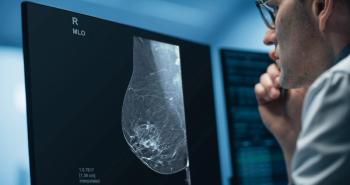
How Understanding Breast Density Has Transformed the Future of Radiology
The problem of density and what it has meant for radiologists.
The subject of breast density is a hot topic in breast imaging, perhaps so much that it’s hard to remember a time when radiologists paid little attention to density when reading a mammogram.
Since 2009, 34 states have passed legislation requiring radiologists to inform patients if they have dense breasts on mammography,
The problem of density
Breast density is important because glandular tissue appears as dense and white areas on a mammogram, while fat appears as dark grey areas, and cancer appears as suspicious white growths and/or small white calcifications. So, finding a white cancer within a lot of dense breast tissue is like looking for a snowball in a snowstorm-very difficult.
Related article:
Increased breast density makes it easier to miss a cancer on mammography and can also increase the chance that a patient may be recalled after her screening mammogram for a possible suspicious finding that a subsequent diagnostic mammogram and/or ultrasound may eventually determine to be just normal glandular tissue. False negative findings may lead to a false sense of reassurance and false positive findings may lead to unnecessary anxiety for women, as well as increased healthcare costs.
Another problem is that women with dense breasts are at higher risk, being up to
For these reasons, more attention has been placed on shifting the way physicians manage breast density, including developing and adopting new technology to better assess breast density, which is determined by the amount of breast tissue present on the mammogram and not by how the breast feels on a physical exam.
Currently, the most common way to identify a patient’s breast density is a visual assessment by a radiologist who categorizes breast density levels into four categories: A. fatty, B. scattered fibroglandular, C. heterogeneously dense, and D. extremely dense. The last two categories are considered dense. However, visual breast density assessments can be subjective and variable. For example, it is possible for two radiologists to classify breast density on the same mammogram differently, and this is particularly true when patients are “in the middle” between categories B and C.
To help address this issue, new technology has been developed to automatically detect and determine density-based computer algorithms, removing the subjectivity of the radiologist’s visual assessment. Of course, there are limitations with the computer algorithms, too- radiologists are better at taking nuances of positioning and quality of mammograms into account, which is why technology should be used in conjunction with physicians, not to replace them.
Better understanding of breast density and advancements in technology may benefit patients in a variety of ways. By knowing a woman’s breast density based on her screening mammogram, women may choose to have an additional screening test, such as an ultrasound or MRI. This can ultimately improve patients’ clinical outcomes by catching cancers that could be hiding behind the dense breast tissue on the mammogram. Also, early studies have shown that some women undergoing early treatments or preventative measures for breast cancer show a decrease in their breast density, which may indicate they could be responding better to the treatment. Better and more personalized patient care will benefit the patient, the physicians, and other health care providers.
With advances in technology, breast density assessment will be more accurate and may provide better information. Dense breast tissue is complex and unique to each woman: every normal mammogram is different and the breast can change over time, often effected by hormone changes. New technology has the potential to capture more detailed information regarding breast tissue and could be coupled with other patient specific information, such as breast cancer risk factors including genetics, age, and diet. With more research, radiologists might be able to use this information someday to personalize screening recommendations instead of a “one-size-fits-all” approach.
Related article:
More research and advances in technology will eventually improve how we screen, diagnose, and treat women for breast cancer. It’s important to know that dense breasts, while very common and normal for women to have, are certainly not the only critical area radiologists and patients should focus on. Most breast cancer is found in women with no known risk factors (other than being a woman) and many cancers are found in women without dense breasts. Still, more attention to accurate and reproducible breast density assessment is here to stay-and fortunately there are emerging new tools that will allow radiologists and other physicians to use more precise breast density assessment to help make better patient care decisions.
Newsletter
Stay at the forefront of radiology with the Diagnostic Imaging newsletter, delivering the latest news, clinical insights, and imaging advancements for today’s radiologists.




























